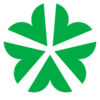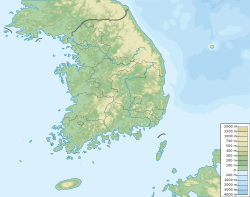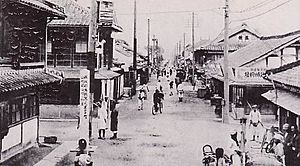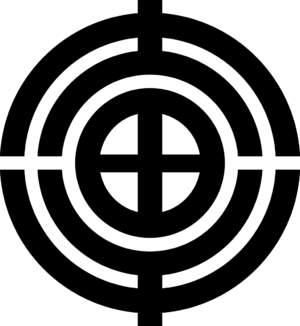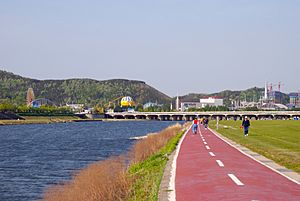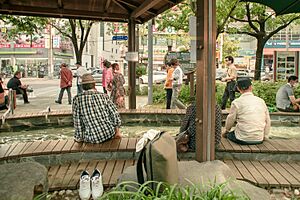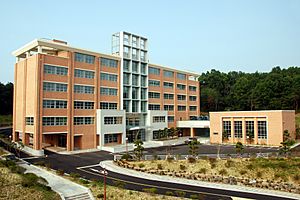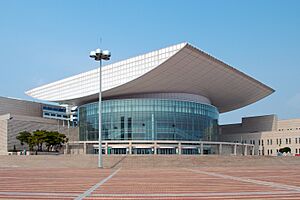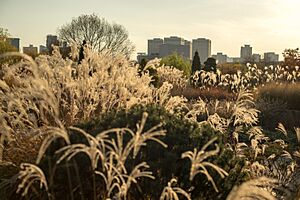Daejeon facts for kids
Quick facts for kids
Daejeon
대전
|
|||
|---|---|---|---|
|
Metropolitan City
|
|||
| Daejeon Metropolitan City 대전광역시 |
|||
| transcription(s) | |||
| • Hangul | 대전광역시 | ||
| • Hanja | 大田廣域市 | ||
| • Revised Romanization | Daejeon-gwangyeoksi | ||
| • McCune-Reischauer | Taejŏn-gwangyŏksi | ||
|
View of Daejeon from Bomunsan Mountain
Uam Historic Park
Daejeoncheon
Government Complex Daejeon
|
|||
|
|||
 |
|||
| Country | South Korea | ||
| Region | Hoseo | ||
| Districts | 5 | ||
| Government | |||
| • Type | Mayor–council | ||
| Area | |||
| • Total | 539.85 km2 (208.44 sq mi) | ||
| Population
(January 2022)
|
|||
| • Total | 1,469,543 | ||
| • Density | 2,722.132/km2 (7,050.29/sq mi) | ||
| • Dialect | Chungcheong | ||
| GDP | |||
| • Total | KR₩ 50 trillion US$ 40 billion (2022) |
||
| ISO 3166 code | KR-30 | ||
| Flower | White magnolia | ||
| Tree | Pine | ||
| Bird | Korean magpie | ||
Daejeon is a large city in South Korea. It's the fifth biggest city in the country, with about 1.5 million people living there. Daejeon is in a valley between mountains and a river. It's famous for its focus on technology and research. The city is also known for its beautiful natural surroundings.
Daejeon is a major transportation hub. It has important train and road routes. You can reach Seoul, the capital city, in about 50 minutes by fast train.
This city is one of South Korea's main administration centers. It has 23 universities and colleges, like Korea Advanced Institute of Science and Technology. Many government research centers and big company research labs, such as Samsung and LG, are also located here. Most of these are in the Daedeok Science Town.
People have lived in the Daejeon area since the Stone Age. For a long time, it was just small villages by the river. It didn't grow much until the early 1900s when it became a train hub. In the 1980s, many government offices moved from Seoul to Daejeon. This caused the city's population to grow a lot.
Daejeon has hosted big events like the Expo 1993. It will also be the main host city for the 2027 Summer World University Games. In 1989, Daejeon became a Metropolitan City.
Contents
History of Daejeon
Human beings first lived in the Daejeon area during the Stone Age. Over time, different groups used this area for military purposes. During the Joseon Kingdom period, it was part of different local areas. In 1895, most of the area became part of Hoideok-gun and Jinjam-gun.
The Daejeon area was once called Hanbat (한밭). This is a Korean name meaning "large field." The name "Daejeon" means the same thing in Hanja (Chinese characters).
Daejeon used to be a small village. But in 1905, the Gyeongbu Railway opened a station here. This train line connected Seoul to Busan. Then, in 1926, the Honam Railway was built. It connected Mokpo to Daejeon. These railways made Daejeon a very important transportation center. Because of this, the city grew quickly.
During the time of Japanese rule, many Japanese people moved to Daejeon. They took advantage of the new railway system. By 1910, more than half of Daejeon's population was Japanese. This meant Japanese culture had a big influence on the city. For example, some older people still use Japanese-influenced words.
In 1932, Daejeon became the capital of South Chungcheong Province. During the Korean War, a major conflict called the Battle of Taejon happened here.
Since then, Daejeon's borders have changed. Its official name has also changed over time. In 1983, the nearby town of Daedeok became part of the city. In the late 1980s, Daejeon became a Special City. This meant it was a separate administrative region. In 1995, it was renamed a Metropolitan City. This is its official name today.
In the 1980s, the Korean government started moving offices from Seoul to Daejeon. The Daejeon Government Complex opened in 1997. Today, many national government offices are in Daejeon. These include the Korea Customs Service and the Korea Forest Service.
More recently, Sejong City was built nearby in 2013. Some public institutions moved there from Daejeon and Seoul. This led to some people moving from Daejeon to Sejong.
Geography and Climate
Daejeon is located in the middle of South Korea. It's about 167 kilometers (104 miles) south of Seoul. It's also about 294 kilometers (183 miles) from Busan.
The city is in a large valley. It is surrounded by several mountains. These include Gyeryongsan National Park to the west. Three main rivers flow through the city: Gapcheon, Yudeungcheon, and Daejeoncheon. These rivers flow north and join the Geum River. The Geum River then flows into the Yellow Sea.
Daejeon's Weather
| Weather chart for Daejeon | |||||||||||||||||||||||||||||||||||||||||||||||
|---|---|---|---|---|---|---|---|---|---|---|---|---|---|---|---|---|---|---|---|---|---|---|---|---|---|---|---|---|---|---|---|---|---|---|---|---|---|---|---|---|---|---|---|---|---|---|---|
| J | F | M | A | M | J | J | A | S | O | N | D | ||||||||||||||||||||||||||||||||||||
|
26
4
-6
|
37
7
-4
|
52
13
1
|
82
19
7
|
92
25
13
|
167
28
18
|
307
30
22
|
300
30
23
|
153
26
17
|
59
21
9
|
48
14
3
|
30
6
-3
|
||||||||||||||||||||||||||||||||||||
| temperatures in °C precipitation totals in mm |
|||||||||||||||||||||||||||||||||||||||||||||||
|
Imperial conversion
|
|||||||||||||||||||||||||||||||||||||||||||||||
Daejeon has four distinct seasons. Its climate is affected by monsoons. Winters are cold and dry. The average temperature in January is about -1.0°C (30.2°F). Summers are hot and humid. The average temperature in August is about 25.6°C (78.1°F). Most of the rain falls in July and August during the Korean monsoon season.
| Climate data for Daejeon (1991–2020 normals, extremes 1969–present) | |||||||||||||
|---|---|---|---|---|---|---|---|---|---|---|---|---|---|
| Month | Jan | Feb | Mar | Apr | May | Jun | Jul | Aug | Sep | Oct | Nov | Dec | Year |
| Record high °C (°F) | 16.6 (61.9) |
22.6 (72.7) |
26.1 (79.0) |
30.4 (86.7) |
33.3 (91.9) |
35.7 (96.3) |
37.7 (99.9) |
39.4 (102.9) |
36.0 (96.8) |
31.2 (88.2) |
26.3 (79.3) |
19.8 (67.6) |
39.4 (102.9) |
| Mean daily maximum °C (°F) | 4.1 (39.4) |
7.0 (44.6) |
12.7 (54.9) |
19.4 (66.9) |
24.5 (76.1) |
27.9 (82.2) |
29.6 (85.3) |
30.3 (86.5) |
26.3 (79.3) |
20.8 (69.4) |
13.5 (56.3) |
6.2 (43.2) |
18.5 (65.3) |
| Daily mean °C (°F) | −1.0 (30.2) |
1.4 (34.5) |
6.6 (43.9) |
13.0 (55.4) |
18.5 (65.3) |
22.7 (72.9) |
25.5 (77.9) |
26.0 (78.8) |
21.2 (70.2) |
14.6 (58.3) |
7.7 (45.9) |
1.0 (33.8) |
13.1 (55.6) |
| Mean daily minimum °C (°F) | −5.5 (22.1) |
−3.6 (25.5) |
1.1 (34.0) |
6.9 (44.4) |
12.8 (55.0) |
18.1 (64.6) |
22.2 (72.0) |
22.5 (72.5) |
17.0 (62.6) |
9.4 (48.9) |
2.8 (37.0) |
−3.4 (25.9) |
8.4 (47.1) |
| Record low °C (°F) | −18.6 (−1.5) |
−19.0 (−2.2) |
−10.7 (12.7) |
−2.9 (26.8) |
3.1 (37.6) |
8.1 (46.6) |
13.0 (55.4) |
12.3 (54.1) |
4.2 (39.6) |
−2.9 (26.8) |
−11.4 (11.5) |
−17.7 (0.1) |
−19.0 (−2.2) |
| Average precipitation mm (inches) | 25.5 (1.00) |
37.2 (1.46) |
51.6 (2.03) |
81.6 (3.21) |
91.8 (3.61) |
167.3 (6.59) |
306.9 (12.08) |
299.8 (11.80) |
152.5 (6.00) |
59.3 (2.33) |
48.0 (1.89) |
29.7 (1.17) |
1,351.2 (53.20) |
| Average precipitation days (≥ 0.1 mm) | 8.0 | 7.0 | 8.3 | 8.3 | 8.2 | 9.9 | 16.4 | 14.8 | 9.1 | 6.1 | 8.5 | 9.3 | 113.9 |
| Average snowy days | 9.8 | 6.0 | 2.8 | 0.2 | 0.0 | 0.0 | 0.0 | 0.0 | 0.0 | 0.1 | 2.1 | 7.9 | 28.9 |
| Average relative humidity (%) | 65.3 | 60.3 | 57.9 | 56.9 | 62.4 | 69.8 | 79.1 | 78.2 | 75.3 | 71.8 | 69.3 | 67.9 | 67.9 |
| Mean monthly sunshine hours | 168.2 | 176.2 | 207.7 | 220.5 | 239.8 | 198.5 | 155.5 | 177.0 | 180.3 | 205.1 | 162.4 | 162.5 | 2,253.7 |
| Percent possible sunshine | 52.7 | 56.1 | 54.0 | 54.0 | 51.2 | 41.3 | 31.4 | 37.6 | 45.1 | 56.1 | 52.5 | 53.9 | 48.0 |
| Average ultraviolet index | 2 | 2 | 3 | 4 | 5 | 6 | 6 | 5 | 5 | 3 | 2 | 2 | 4 |
| Source 1: Korea Meteorological Administration (percent sunshine 1981–2010) | |||||||||||||
| Source 2: Weather Atlas (UV) | |||||||||||||
City Districts and People
Daejeon is split into five main areas called "gu" or "districts." These are:
- Seogu
- Donggu
- Yuseonggu
- Daedeokgu
- Junggu
Seo District is the most populated area. It has about 474,000 residents.
Who Lives in Daejeon?
As of 2023, Daejeon has about 1.46 million residents. About 1.5% of the population are foreign residents. Many of these are from Vietnam and China. There are also people from many other countries living in Daejeon.
What Religions are Practiced?
Religion in Daejeon (2005) Folk religion or Not religious (47%) Buddhism (21.8%) Protestantism (20.5%) Catholicism (10.7%)
According to a 2005 study, many people in Daejeon follow Buddhism. A large number also follow Christianity, including Protestantism and Catholicism.
Education and Research
Daejeon is a city of learning and discovery. It has 23 universities and colleges. About 90,000 students study here.
Universities in Daejeon
Some of the main public universities include:
- Chungnam National University: This university is known for biotechnology and medicine.
- Daejeon Chungnam University: Part of a national university system.
- Hanbat National University: This school focuses on working with businesses.
- Korea Advanced Institute of Science and Technology (KAIST): This is a top science and engineering school. It was ranked the best Asian science and technology school in 2000.
Some important private universities are:
- Mokwon University: A Christian university.
- Pai Chai University: One of the oldest private universities in South Korea, founded in 1885.
- Woosong University: Known for its focus on international studies and IT.
- Hannam University: Founded by Christian missionaries in 1956.
There are also special high schools:
- Daejeon Foreign Language High School: Teaches 7 different languages.
- Daejeon Science High School: Focuses on science education.
- Taejon Christian International School: An international school.
Research and Development Hub
Daejeon is known as Korea's center for research and development. Besides KAIST, it has over 20 government research centers. Many company research centers are also located here. Most of these are in Daedeok Innopolis, a science park.
Researchers in Daejeon work on many exciting topics. These include:
- Telecommunications
- Biotechnology
- Nuclear and hydro power
- Nuclear fusion
- Robotics
- New materials
- Environmental technologies
Daedeok Innopolis has nearly 900 companies. It also has many government institutions and universities. Some famous technologies developed here include wireless communication systems and satellites.
Daejeon was chosen to be the core of the International Science and Business Belt in 2013.
Culture and Fun
Daejeon has many places for arts and culture. Most of them are in the Daedeok area.
Museums and Arts
- Daejeon Museum of Art: Shows modern art, often with a focus on technology.
- Daejeon Arts Center: Home to local music and theater groups.
- Lee Ungno Museum: Has a large collection of works by the famous Korean artist Lee Ungno.
- Expo Science Park: Built on the site of the 1993 international exposition. It has the Institute for Basic Science and the National Science Museum. The museum shows how nature, people, and technology work together. It also has an astronomical observatory.
- Geological Museum: Belongs to the Korea Institute of Geoscience and Mineral Resources.
- Daejeon Citizen's Observatory: The first citizen observatory in Korea, with a large telescope.
Other art spaces include the Daejeon Artist House.
Parks and Nature
People in Daejeon love nature. Mountains, hot springs, and rivers are open for everyone to enjoy. Many city traditions and festivals are connected to these natural places.
The city government has named eight "beautiful sights." These include mountains like Sikjangsan and Bomunsan. They also include Daecheonghosu lake and Yuseong Foot Spa. The Expo Science Park is also one of these sights. The Daejeon Hanbat Arboretum is the largest man-made arboretum in Korea. It was built on old parking lots from the World Expo.
Bomunsan Mountain park is south of Daejeon. It has springs, trails, and old temples. It also has a nature healing center and an outdoor concert hall. Daejeon O-World is a theme park there. It includes the Daejeon Zoo, with 160 species of animals.
Festivals
Daejeon hosts many festivals. Some are traditional folk festivals, and others are modern celebrations.
- Daejeon Science Festival
- Hyo Culture Root Festival
- Full Moon Festival
- Yuseong Oncheon Festival
- Gyejoksan Mountain Manbal Festival
Sports in Daejeon
Daejeon has professional sports teams and great sports facilities. The Daejeon World Cup Stadium was built for the 2002 FIFA World Cup. It hosted several games, including a match between South Korea and Italy. Now, it's the home of the city's football club.
The Daejeon Hanbat Sports Complex was built in 1964. It hosted events for the 1986 Asian Games and the 1988 Summer Olympics. Today, it's home to the city's professional baseball and volleyball teams.
Football Teams
- Daejeon Hana Citizen: A professional football club in the K League 1. They play at Daejeon World Cup Stadium.
- Daejeon Korail: Plays in the K3 League at Daejeon Hanbat Sports Complex.
Baseball Team
The Hanwha Eagles are a professional baseball team. They were founded in Daejeon in 1985. They play their home games at the Daejeon Hanbat Baseball Stadium. This stadium has a great view of Bomunsan mountain. It was updated in 2013 and can seat 13,000 people.
Volleyball Teams
- Daejeon Samsung Fire Bluefangs: A men's volleyball team in the V-League.
- Daejeon KGC: A women's volleyball team in the V-League.
Both teams play at the Chungmu Gymnasium.
Transportation
Daejeon is a very important place for transportation in South Korea. Two major highways and two major railway lines meet here. You can travel between Daejeon and Seoul in about 50 minutes using the KTX high-speed rail.
The closest airport is Cheongju Airport. It's about a 30-minute drive north. You can also take direct buses to Incheon International Airport.
Subway System
Daejeon has one subway line that has been running since 2007. This line connects Daejeon Station in the old city center to newer areas. These newer areas include Dunsan, where the city hall is located.
The Daejeon subway cars are narrower than Seoul's. They also have storage space under the seats. The system uses a special card called T-money to pay for fares. All subway stations have safety doors on the platforms.
Public Bicycles
Daejeon has a public bicycle service called '타슈(Tashu). The name "Tashu" comes from the local Chungcheong dialect. It means "please ride" in standard Korean. Tashu is an unmanned rental service that started in 2008. You can rent a bike for a small fee.
Images for kids
Famous People from Daejeon
- An Yu-jin, singer (Iz*One, Ive)
- Kim Joon-ho, comedian
- Do Ji-han, actor
- Choi Sung-bong, singer
- Han Eun-jung, actress
- Yoon Joo-hee, actress
- Han Sang-hyuk, singer (VIXX)
- Hong Jin-ho, TV personality and former professional StarCraft player
- Ivy, singer and musical actress
- Kwon Sang-woo, actor
- Lee Na-eun, singer and actress (April)
- Lee Yoon-ki, film director
- Pak Se-ri, former professional golfer
- Joon Park, artist
- Ryu Su-jeong, singer (Lovelyz)
- Shin Seung-hun, singer-songwriter
- Song Joong-ki, actor
- Chen, singer (EXO)
- Kyu Ha Kim, judoka
- Baek Ye-rin, singer (15&)
- Park Ji-min, singer (15&)
- Jo Bo-ah, actress
- Sunghoon, singer (Enhypen)
- Son Suk-ku, actor
- Choi Jung-in, singer
- Kim Woo-seok, singer (X1, Up10tion) and actor
- FlaSh, StarCraft: Brood War and StarCraft II player
- Paul Sun-Hyung Lee, actor
- Kim Dong-hyun, singer (AB6IX)
- Yeo One, singer (Pentagon) and actor
- Kwak Dong-yeon, actor
- Jeon Heejin, singer (Loona)
- Lee Hae-in, figure skater
- Kim Duk-soo, traditional musician
Sister Cities
Daejeon has special partnerships with many cities around the world. These are called "sister cities."
| City | Country | Year |
|---|---|---|
| Oda | 1987 | |
| Seattle | 1989 | |
| Budapest | 1994 | |
| Nanjing | 1994 | |
| Calgary | 1996 | |
| Guadalajara | 1997 | |
| Uppsala | 1999 | |
| Novosibirsk | 2001 | |
| Brisbane | 2002 | |
| Bình Dương Province | 2005 | |
| Sapporo | 2010 | |
| Durban | 2011 | |
| Purwokerto | 2014 | |
| Bandung | 2015 | |
| Montgomery County | 2017 | |
| Siem Reap | 2019 |
See also
 In Spanish: Daejeon para niños
In Spanish: Daejeon para niños








